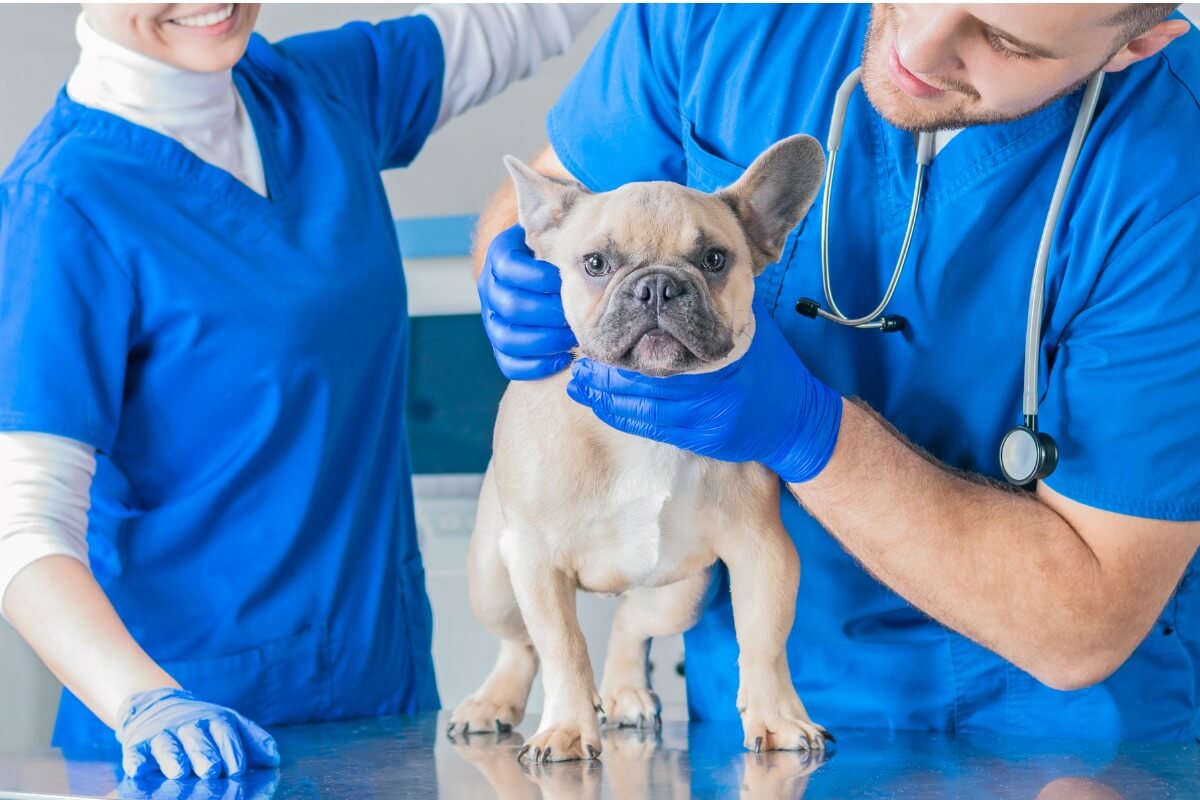The Most Common Diseases in French Bulldogs

Among all the bulldog breeds, the French bulldog is the one with the fewest health problems. However, and as with all canine variants artificially selected by man, this brings with it certain ailments typical of its morphology and genetics. Find out about the most common diseases in French bulldogs in this article.
The French bulldog is one of the most popular breeds in homes due to its flat muzzle and cheerful character. However, and for the sake of prevention, it’s important to get to know the most important diseases that afflict these dogs. In this space, you can learn more about them, so don’t miss it.
What are the most common diseases in French bulldogs?
A study conducted in 2013 revealed the high percentage of minor health problems in this breed, such as conjunctivitis, otitis, and diarrhea. However, the most frequent pathologies were respiratory, with a 12.7% prevalence in the patients of the chosen sample.
In addition, in this same study, it was also found that males had worse general health than females, being susceptible to suffer a greater number of pathologies than them. However, in the list below you’ll find the most common diseases in French bulldogs regardless of the animal’s sex.

Brachycephalic dog syndrome
This syndrome is certainly the most common pathology in bulldogs and other snub-nosed breeds. This problem is a direct consequence of the selective breeding of dogs, and the demand for more and more accentuated aesthetic features, such as the sunken muzzle.
In brachycephalic dog syndrome, due to the morphology of the head, the soft palate is elongated, the nostrils are too narrow and the laryngeal saccules (located just before the vocal cords) are displaced towards the trachea. Thus, the airways are much narrower than normal and cause various problems. We highlight the following:
- Paralysis of the laryngeal cartilages
- The collapse of the larynx (air doesn’t pass into the lungs)
- Snoring
- Difficulty breathing through the nose: hence the hoarse breathing so characteristic of these breeds
- Aversion to exercise
The solution is almost always surgery, in which the nostrils are altered to facilitate nasal breathing and the soft palate is resected. With the latter, the soft palate doesn’t touch the glottis and allows air to pass into the lungs. The laryngeal saccules aren’t modified unless they’re causing a problem.
Histiocytic ulcerative colitis
This is an inflammatory disease of the colon that causes ulcers in its internal wall. The dog will suffer from continuous bloody diarrhea, weight loss, dehydration, and malnutrition. The prognosis improves with early detection of the disease, but lifelong treatment will be necessary.
Entropion
Entropion is a folding of the dog’s eyelid inward, causing the eyelashes to rub against the eyeball. If left untreated, the eye becomes severely irritated and causes great pain to the animal. It’s even possible for ulcers to appear over time.
Hemivertebra
This consists of a vertebral malformation that compresses the spinal cord. Depending on the severity, it causes intense pain in the back, and can even cause paralysis and lack of sphincter control.
Intervertebral disc disease
This disease begins when the disc that separates the vertebrae ruptures and slips out of place, compressing the spinal cord. It’s a type of herniated disc with the same consequences as the hemivertebra: pain, paralysis, loss of sensation, and loss of sphincter control, etc.
Cleft lip and palate
This is a congenital defect that occurs during embryonic development and causes an opening in the roof of the mouth. Depending on its severity, the puppy may not be able to suckle due to the danger of aspiration choking.
Cataracts
The lens is the intraocular structure that sits just behind the iris. When it becomes cloudy it becomes opaque, hindering vision, and giving the eye its characteristic whitish, bluish appearance. Cataracts are usually removed surgically, otherwise they lead to total blindness over time.
The more bulldogs, the more problems
Selective breeding has been openly criticized for being the source of many of the most common diseases in French bulldogs, as well as many other breeds. Unfortunately, the appearance of dogs is also considered a fad, and the greater the demand for certain characteristics (such as a flat nose), the more puppies will be offered for sale with physical problems.
This problem is further exacerbated when an animal is purchased from an inexperienced or unofficial breeder. Many pathologies typical of purebred breeds are caused by parental genetics and could be prevented by avoiding the crossing of dogs carrying mutations. Unfortunately, very often the relevant tests aren’t carried out because of their cost.
In England alone, the demand for French bulldog puppies rose by 1.46% in 10 years.

If you’re thinking of expanding your family with a dog, we would urge you to adopt and not buy. We need to take action to stop promoting an industry that continues to breed certain dog breeds without taking into account the damage to their quality of life.
Among all the bulldog breeds, the French bulldog is the one with the fewest health problems. However, and as with all canine variants artificially selected by man, this brings with it certain ailments typical of its morphology and genetics. Find out about the most common diseases in French bulldogs in this article.
The French bulldog is one of the most popular breeds in homes due to its flat muzzle and cheerful character. However, and for the sake of prevention, it’s important to get to know the most important diseases that afflict these dogs. In this space, you can learn more about them, so don’t miss it.
What are the most common diseases in French bulldogs?
A study conducted in 2013 revealed the high percentage of minor health problems in this breed, such as conjunctivitis, otitis, and diarrhea. However, the most frequent pathologies were respiratory, with a 12.7% prevalence in the patients of the chosen sample.
In addition, in this same study, it was also found that males had worse general health than females, being susceptible to suffer a greater number of pathologies than them. However, in the list below you’ll find the most common diseases in French bulldogs regardless of the animal’s sex.

Brachycephalic dog syndrome
This syndrome is certainly the most common pathology in bulldogs and other snub-nosed breeds. This problem is a direct consequence of the selective breeding of dogs, and the demand for more and more accentuated aesthetic features, such as the sunken muzzle.
In brachycephalic dog syndrome, due to the morphology of the head, the soft palate is elongated, the nostrils are too narrow and the laryngeal saccules (located just before the vocal cords) are displaced towards the trachea. Thus, the airways are much narrower than normal and cause various problems. We highlight the following:
- Paralysis of the laryngeal cartilages
- The collapse of the larynx (air doesn’t pass into the lungs)
- Snoring
- Difficulty breathing through the nose: hence the hoarse breathing so characteristic of these breeds
- Aversion to exercise
The solution is almost always surgery, in which the nostrils are altered to facilitate nasal breathing and the soft palate is resected. With the latter, the soft palate doesn’t touch the glottis and allows air to pass into the lungs. The laryngeal saccules aren’t modified unless they’re causing a problem.
Histiocytic ulcerative colitis
This is an inflammatory disease of the colon that causes ulcers in its internal wall. The dog will suffer from continuous bloody diarrhea, weight loss, dehydration, and malnutrition. The prognosis improves with early detection of the disease, but lifelong treatment will be necessary.
Entropion
Entropion is a folding of the dog’s eyelid inward, causing the eyelashes to rub against the eyeball. If left untreated, the eye becomes severely irritated and causes great pain to the animal. It’s even possible for ulcers to appear over time.
Hemivertebra
This consists of a vertebral malformation that compresses the spinal cord. Depending on the severity, it causes intense pain in the back, and can even cause paralysis and lack of sphincter control.
Intervertebral disc disease
This disease begins when the disc that separates the vertebrae ruptures and slips out of place, compressing the spinal cord. It’s a type of herniated disc with the same consequences as the hemivertebra: pain, paralysis, loss of sensation, and loss of sphincter control, etc.
Cleft lip and palate
This is a congenital defect that occurs during embryonic development and causes an opening in the roof of the mouth. Depending on its severity, the puppy may not be able to suckle due to the danger of aspiration choking.
Cataracts
The lens is the intraocular structure that sits just behind the iris. When it becomes cloudy it becomes opaque, hindering vision, and giving the eye its characteristic whitish, bluish appearance. Cataracts are usually removed surgically, otherwise they lead to total blindness over time.
The more bulldogs, the more problems
Selective breeding has been openly criticized for being the source of many of the most common diseases in French bulldogs, as well as many other breeds. Unfortunately, the appearance of dogs is also considered a fad, and the greater the demand for certain characteristics (such as a flat nose), the more puppies will be offered for sale with physical problems.
This problem is further exacerbated when an animal is purchased from an inexperienced or unofficial breeder. Many pathologies typical of purebred breeds are caused by parental genetics and could be prevented by avoiding the crossing of dogs carrying mutations. Unfortunately, very often the relevant tests aren’t carried out because of their cost.
In England alone, the demand for French bulldog puppies rose by 1.46% in 10 years.

If you’re thinking of expanding your family with a dog, we would urge you to adopt and not buy. We need to take action to stop promoting an industry that continues to breed certain dog breeds without taking into account the damage to their quality of life.
All cited sources were thoroughly reviewed by our team to ensure their quality, reliability, currency, and validity. The bibliography of this article was considered reliable and of academic or scientific accuracy.
- Dan G. O’Neill et al. “Demography and disorders of the French Bulldog population under primary veterinary care in the UK in 2013” Canine Genetics and Epidemiology mayo de 2018
- Enfermedad de Disco Intervertebral | American College of Veterinary Surgeons – ACVS. (s. f.). American College of Veterinary Surgeons. Recuperado 1 de diciembre de 2021, de https://www.acvs.org/small-animal-es/intervertebral-disc-disease
- Síndrome Braquicefálico | American College of Veterinary Surgeons – ACVS. (s. f.). American College of Veterinary Surgeons. Recuperado 1 de diciembre de 2021, de https://www.acvs.org/small-animal-es/brachycephalic-syndrome
This text is provided for informational purposes only and does not replace consultation with a professional. If in doubt, consult your specialist.








